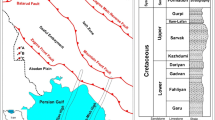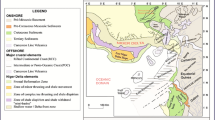Hydraulic fracturing of tight sandstone reservoirs is an important method of developing this type of unconventional oil and gas resources. The evaluation of in-situ stress distribution and rock mechanical parameters of fractured wells is the prerequisite for fracturing design. Therefore, the development of a calculation method to evaluate the stress distribution and mechanical parameters of rocks, based on a single well in-situ stress data, is the key to establish the optimal fracturing design. In this paper, based on the correlation between the laboratory experimental data and the logging response, we have plotted the initial stress profile and then applied the proposed method of combining density curve and natural gamma curve to correct the calculation results. In the case of a limited number of wells, the obtained profile correction model demonstrated satisfactory matching with laboratory experimental data.







Similar content being viewed by others
References
C. Zou, R. Zhu, S. Wu, et al., “Types, characteristics, genesis, and prospects of conventional and unconventional hydrocarbon accumulations: taking tight oil and tight gas in China as an instance,” Pet. Explor. Dev., 33(2), 173-187 (2012).
Z. Sun, C. Jia, X. Li, et al., Unconventional Oil & Gas Exploration and Development (upper volumes), Petroleum Industry Press, Beijing (2011).
E. J. Nelson, J. J. Meyer, R. R. Hillis, et al., “Transverse drilling-induced tensile fractures in the West Tuna area, Gippsland Basin, Australia: implications for the in-situ stress regime,” Int. J. Rock Mech. Min. Sci., 42(3), 361-371 (2005).
L. Song, Z. Liu, C. Li, et al., “Geostress logging evaluation method of tight sandstone based on transversely isotropic mode,” Acta Pet. Sin., 36(6), 707-714 (2015).
Y. Hu, S. Jia, J. Zhao, et al., “Study on controlling conditions in network hydraulic fracturing,” J. Southwest Pet. Univ.: Sci. Technol. Ed., 35(4):126-132 (2013).
Y. Li, Y. Peng, and Z. Wang, “Analysis of shale gas fracture stimulation mechanism and operating techniques,” J. Southwest Pet. Univ.: Sci. Technol. Ed., 35(2), 90-96 (2013).
J. Zhao, L. Ren, and Y. Hu, “Controlling factors of hydraulic fractures extending into network in shale formations,” J. Southwest Pet. Univ.: Sci. Technol. Ed., 35(1), 1-9 (2013).
X. Wang, J. Wu, and J. Zhang, “Application of CO2 fracturing technology for terrestrial shale gas reservoirs,” Nat. Gas Ind., 34(1), 64-67 (2014).
J. Talobre, La Mecanique des Roches, Dunod, Paris (1957).
K. Terzaghi and F. E. Richart, Stress in rock about cavities, Geotehnique, 3(2), 57-90 (1952).
R. Huang and J. Zhuang, “A new formation fracture pressure prediction method,” Oil Drill. Prod. Technol., 3(1), 1-14 (1986).
Z. Li and J. Zhang, Stress and Oil and Gas Exploration and Development, Petroleum Industry Press, Beijing (1996).
P. W. Holbrook, “The use of petrophysical data for well planning, drilling safety, and efficiency,” SPWLA 37th Annual Logging Symposium, Houston, June 16-19 (1996).
P. W. Holbrook, “Discussion of a new simple method to estimate fracture pressure gradients,” SPE Drill. Complet., 1(3), 1-12 (1997).
H. Ge, Y. Lin, S. Ma, et al., “Modification of Holbrook’s fracture pressure prediction model,” Pet. Drill. Tech., 29(3), 20-22 (2001).
G. Xie, “A new method to calculate the maximum and minimum horizontal stress using log data,” Well Logg. Technol., 29(1):82-89 (2005).
B. Amadei, W. Z. Savage, and H. S. Swolfs, “Gravitational stresses in anisotropic rock masses,” Int. J. Rock Mech. Min. Sci., 24(1), 5-14 (1987).
B. Amadei, H. S. Swolfs, and W.S. Savage, “Gravity induced stresses in stratified rock masses,” Rock Mech. Rock Eng., 21, 1-20 (1988).
M. J. Thiercelin and R. A. Plumb, “Core-based prediction of lithologic stress contrasts in East Texas formation,” SPE, 251-257 (1994).
S. Higgins, S. Goodwin, A. Donald, T. Bratton, and G. Tracy, “Anisotropic stress models improve completion design in Baxter shale,” SPE Annual Technical Conference and Exhibition, 1-10 (2008).
J. C. Jaeger, N. G. Cook, and R. W. Zimmerman, Fundamentals of Rock Mechanics, 4th ed., Wiley-Blackwell, Oxford (2007).
M. D. Zoback, C. A. Barton, M. Brudy, et al., “Determination of stress orientation and magnitude in deep wells,” Int. J. Rock Mech. Min. Sci., 40(7-8), 1049-1076 (2003).
M. J. Mullen, R. Roundtree, and G. A. Turk, “A composite determination of mechanical rock properties for stimulation design (what to do when you don’t have a sonic log),” SPE:108139-MS, Rocky Mountain Oil & Gas Technology Symposium, 16-18 April, Denver, Colorado, USA (2007).
R. Rickma, M. J. Mullen, A practical use of shale petrophysics for stimulation design optimization: All shale plays are not clones of the Barnett Shale,” SPE:115258-MS, SPE Annual Technical Conference and Exhibition, 21-24 Sept., Denver, Colorado, USA (2008).
M. A. Biot, “General theory of three-dimensional consolidation,” J. Appl. Phys.,12(2), 155-164 (1941).
B. L. Wu, “Biot’s effective stress coefficient evaluation: static and dynamic approaches,” Frontiers of Rock Mechanics and Sustainable Development in the 21st Century, Proceedings of the 2nd ISRM International Symposium, Beijing, China (2001).
Author information
Authors and Affiliations
Corresponding author
Additional information
Translated from Khimiya i Tekhnologiya Topliv i Masel, No. 3, pp. 70–76, May–June, 2021.
Rights and permissions
About this article
Cite this article
Han, X., Yi, Xy., Zhou, Cl. et al. Study on Rock Mechanics Parameters and In-Situ Stress Profile Construction and Correction Method Based on Well Log Interpretation. Chem Technol Fuels Oils 57, 518–528 (2021). https://doi.org/10.1007/s10553-021-01274-3
Published:
Issue Date:
DOI: https://doi.org/10.1007/s10553-021-01274-3




